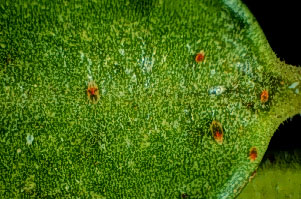


Privet Mites
Description
Because of the similarities in appearance and behavior which they share with Spider Mites, Privet Mites are sometimes called "false spider mites." Privet Mites are dark red in color and measure about 1/100 inch. Because of their very small size, you will probably need a magnifying glass to identify them. Like Spider Mites, Privet Mites typically gather on the underside of leaves, along the leaf veins. Unlike Spider Mites, however, they do not produce webs. Also, Privet Mites are typically only found in warmer climates, whereas Spider Mites can found throughout the U.S. and North America. The damage that Privet Mites cause is compounded by the fact that many mites carry Botrytis.
Distinguishing Symptoms
Privet Mites look very similar to Spider Mites and leave behind many of the same symptoms. One noticeable difference will be the absence of webs, which Privet Mites do not produce. Also, Privet Mites are typically only found in warmer climates, whereas Spider Mites can found throughout the U.S. and North America. This said, do not let yourself get caught up in making a definitive identification. It is enough to know that they are mites. The treatment for all mites is the same. (See below.)
Other Symptoms
Treatment
First, isolate all infested plants. This is important, since Privet Mites move quickly from plant to plant.
Next, treat with Dicofol (as directed on the label). You will need to spray three times, once every fourth day after the initial treatment. Be sure that the spray reaches the underside of the leaves, since this is where most Privet Mites tend to concentrate.
As an alternative to traditional chemical treatments, try spraying with Neem (Azadirachtin). Neem is a substance which has natural insecticidal properties, and according to currently available research, it is biodegradable and non-toxic. When sprayed on African Violets, it discourages Privet Mites by making the plant unpalatable. Though Neem does have some systemic effect in plants, spray it as you would other contact insecticides, being sure to spray the undersides of the leaves where Privet Mites tend to cluster.
Prevention
Always isolate new plants until you can positively determine that they are not infested.
Thoroughly wash hands before handling your plants.
Before repotting, pasteurize soil and disinfect pots with a 10 percent bleach solution, i.e., 1 part bleach to 9 parts water.
Important Note on the Use of Pesticides
Please note that almost all pesticides are formulated for specific uses and conditions. When applied incorrectly, pesticides can cause ill health or damage to plants. Therefore, when using any kind of pesticide or chemical treatment, always apply as indicated on the product label.
 |
| Begin New Diagnosis |
| Doctor Optimara Main Page | Glossary of Violet Terms | Contact Optimara |
| Pests, Pathogens and Cultural Problems (Complete List) |
Copyright 1999 Optimara/Holtkamp Greenhouses, Inc. Nashville, Tennessee. Doctor Optimara is a trademark of Holtkamp Greenhouses, Inc. Optimara and the Optimara logo are trademarks of International Plant Breeding, A.G., Switzerland.